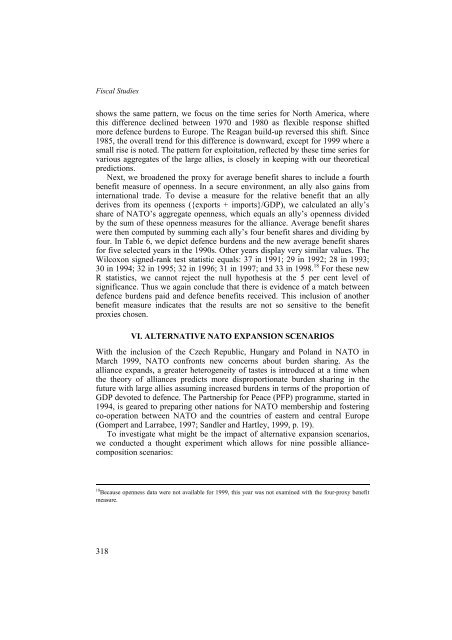On sharing NATO defence burdens in the 1990s and beyond
On sharing NATO defence burdens in the 1990s and beyond
On sharing NATO defence burdens in the 1990s and beyond
You also want an ePaper? Increase the reach of your titles
YUMPU automatically turns print PDFs into web optimized ePapers that Google loves.
Fiscal Studiesshows <strong>the</strong> same pattern, we focus on <strong>the</strong> time series for North America, wherethis difference decl<strong>in</strong>ed between 1970 <strong>and</strong> 1980 as flexible response shiftedmore <strong>defence</strong> <strong>burdens</strong> to Europe. The Reagan build-up reversed this shift. S<strong>in</strong>ce1985, <strong>the</strong> overall trend for this difference is downward, except for 1999 where asmall rise is noted. The pattern for exploitation, reflected by <strong>the</strong>se time series forvarious aggregates of <strong>the</strong> large allies, is closely <strong>in</strong> keep<strong>in</strong>g with our <strong>the</strong>oreticalpredictions.Next, we broadened <strong>the</strong> proxy for average benefit shares to <strong>in</strong>clude a fourthbenefit measure of openness. In a secure environment, an ally also ga<strong>in</strong>s from<strong>in</strong>ternational trade. To devise a measure for <strong>the</strong> relative benefit that an allyderives from its openness ({exports + imports}/GDP), we calculated an ally’sshare of <strong>NATO</strong>’s aggregate openness, which equals an ally’s openness dividedby <strong>the</strong> sum of <strong>the</strong>se openness measures for <strong>the</strong> alliance. Average benefit shareswere <strong>the</strong>n computed by summ<strong>in</strong>g each ally’s four benefit shares <strong>and</strong> divid<strong>in</strong>g byfour. In Table 6, we depict <strong>defence</strong> <strong>burdens</strong> <strong>and</strong> <strong>the</strong> new average benefit sharesfor five selected years <strong>in</strong> <strong>the</strong> <strong>1990s</strong>. O<strong>the</strong>r years display very similar values. TheWilcoxon signed-rank test statistic equals: 37 <strong>in</strong> 1991; 29 <strong>in</strong> 1992; 28 <strong>in</strong> 1993;30 <strong>in</strong> 1994; 32 <strong>in</strong> 1995; 32 <strong>in</strong> 1996; 31 <strong>in</strong> 1997; <strong>and</strong> 33 <strong>in</strong> 1998. 18 For <strong>the</strong>se newR statistics, we cannot reject <strong>the</strong> null hypo<strong>the</strong>sis at <strong>the</strong> 5 per cent level ofsignificance. Thus we aga<strong>in</strong> conclude that <strong>the</strong>re is evidence of a match between<strong>defence</strong> <strong>burdens</strong> paid <strong>and</strong> <strong>defence</strong> benefits received. This <strong>in</strong>clusion of ano<strong>the</strong>rbenefit measure <strong>in</strong>dicates that <strong>the</strong> results are not so sensitive to <strong>the</strong> benefitproxies chosen.VI. ALTERNATIVE <strong>NATO</strong> EXPANSION SCENARIOSWith <strong>the</strong> <strong>in</strong>clusion of <strong>the</strong> Czech Republic, Hungary <strong>and</strong> Pol<strong>and</strong> <strong>in</strong> <strong>NATO</strong> <strong>in</strong>March 1999, <strong>NATO</strong> confronts new concerns about burden <strong>shar<strong>in</strong>g</strong>. As <strong>the</strong>alliance exp<strong>and</strong>s, a greater heterogeneity of tastes is <strong>in</strong>troduced at a time when<strong>the</strong> <strong>the</strong>ory of alliances predicts more disproportionate burden <strong>shar<strong>in</strong>g</strong> <strong>in</strong> <strong>the</strong>future with large allies assum<strong>in</strong>g <strong>in</strong>creased <strong>burdens</strong> <strong>in</strong> terms of <strong>the</strong> proportion ofGDP devoted to <strong>defence</strong>. The Partnership for Peace (PFP) programme, started <strong>in</strong>1994, is geared to prepar<strong>in</strong>g o<strong>the</strong>r nations for <strong>NATO</strong> membership <strong>and</strong> foster<strong>in</strong>gco-operation between <strong>NATO</strong> <strong>and</strong> <strong>the</strong> countries of eastern <strong>and</strong> central Europe(Gompert <strong>and</strong> Larrabee, 1997; S<strong>and</strong>ler <strong>and</strong> Hartley, 1999, p. 19).To <strong>in</strong>vestigate what might be <strong>the</strong> impact of alternative expansion scenarios,we conducted a thought experiment which allows for n<strong>in</strong>e possible alliancecompositionscenarios:18 Because openness data were not available for 1999, this year was not exam<strong>in</strong>ed with <strong>the</strong> four-proxy benefitmeasure.318
















